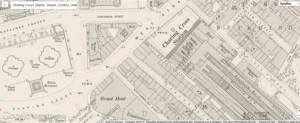I researched Charing Cross in the Sherlock Stories. In “The Man with a Twisted Lip” Charing Cross is only mentioned when Sherlock says “I think, Watson, that you are now standing in the presence of one of the most absolute fools in Europe. I deserve to be kicked from here to Charing Cross” (Doyle). This is when Holmes has figured out that Neville is Hugh Boone and the mention of Charing Cross is rather brief and insignificant. In “A Scandal in Bohemia” Charing Cross plays a bigger role. The woman at Irene Adler’s house explains that Irene “left this morning with her husband, by the 5:15 train from Charing Cross, for the continent” (Doyle). According to The Historical Eye, at Charing Cross there are “two railway stations within a stone’s throw of each other. One of these is the west end terminus of the South Eastern Railway, and the other is a station on the Metropolitan District Railway” (Historical Eye). Using Victorian Google Maps I could only find Charing Cross Station. However, the tracks appear to lead in the direction of the mainland, so it is likely that this is where Irene and her husband fled to in search of a train. The station isn’t technically on the road labeled Charing Cross. It is on West Strand which connects nearby. The map also shows that several different hotels surround the station, indicating that the immediate area was often full of tourists and travelers.

Since the station played a larger role than road itself I looked more into it. According to the Charles Booth Online Archive, the area around the station was mostly well-to-do middle class or fairly comfortable people. This makes sense considering the amount of hotels (and likely other businesses). Having plenty of people coming and going would be good for business. When looking for information about the station on British History Online, I found a section that explained the havoc that had developed due to the creation of railways. The author quoted a writer of an illustrated newspaper who describes the building of railways rather negatively: “the task of destroying houses, or of snapping off odd bits of streets, and leaving maimed and melancholy fragments—unsightly, untenantable, forlorn débris; then the shapeless scraps of land, unneeded by the railway, and unavailable for other purposes” (BHO). This writer has nothing good to say about the railway and continues his rant by explaining “the abominable bridges that cross the roads at ugly angles; of the viaducts that provide dry arches for the congregation and accommodation of street Arabs and gutter children; of the cucumber frames that supply light and air to the underground traffic; of the colossal sheds of stations, notably those that mar the river’s banks” (BHO). It’s interesting that there was such a negative view on the railways while railways remained so important and relied on. This description of the railways shows that the railways had a double edge; they were useful for people to get around but also made a mess of the city. Unfortunately, these background details about Charing Cross don’t seem to reveal anything deeper about the stories. It’s a rather straight forward situation: Irene is fleeing to mainland Europe on a train which is presumably leaving Charing Cross Station. It could be important that there was actually a train station at Charing Cross. If Doyle had made a place up, or chosen a place where she could not have truly caught a train, it would have diminished the authenticity of Irene Adler, the woman who escaped Sherlock Holmes.
